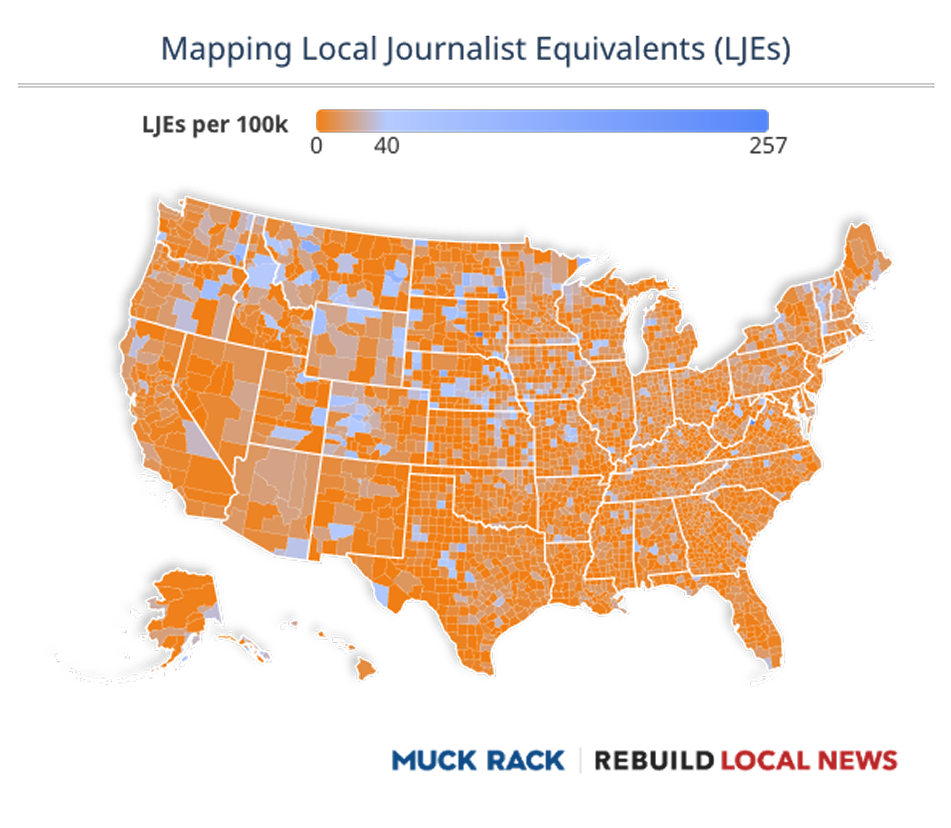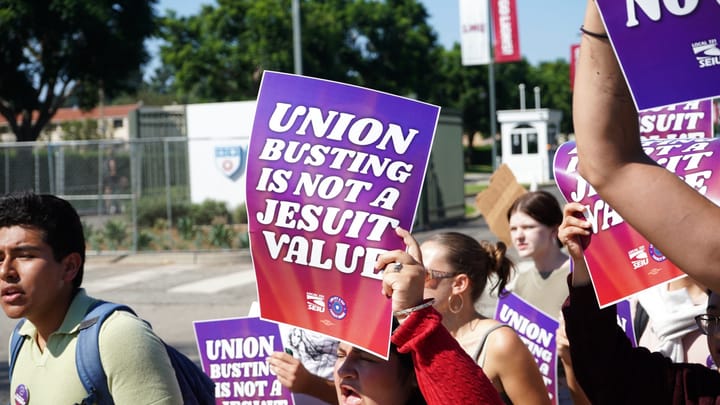Unemployed in America: My Own Story
There's a critical shortage of journalists in the American news industry, with many talented reporters experiencing layoffs just like mine. What can be done about it?

At the end of April, as I was packing up my things to take scheduled vacation time to work on a personal project, my email notification dinged on my phone. One glance at the subject line, “Notice of Layoff:...” and…well, if you’ve been there, you know: heart beating wildly in your throat, face hot, sudden unmistakable panic as you quickly open the email and scan the text for your name. The world closing in around you as it stares back at you, in plain black and white, We intend to lay off the following employees…Melanie Buer…
It’s difficult to truly convey the feeling of having your entire livelihood ripped to shreds right in front of you due to circumstances that were completely beyond your control. I wasn’t fired in the traditional sense–there was no inciting incident that I could point to as evidence of my termination. I hadn’t punched a customer, or missed too many days of work, or any number of reasons that might help me sort through the emotional catastrophe of losing my job. The numbers just didn’t line up, the fundraising was down, the company couldn’t keep paying me. Goodbye stable job.
Any future plans about putting money away to move, to pay off credit cards, to maybe buy a car next year–all things dependent on a salary–dissolved in my hands. It felt like someone had flipped the table and sent me careening into the air with it.
I wish I could say that I took it all in stride–that I accepted the news with head held high and a stiff upper lip, eyes clear and determined; that I responded with grace and a nod and looked forward toward the next adventure. What really happened, as I was struggling to close my suitcase and call an uber to the airport, was that I quite literally collapsed in the living room of my apartment. The word hysterics doesn’t really do the thing justice, to be frank. I managed to call a few friends and sob uncontrollably into the phone, but I doubt they understood a word I said. Bless them for listening anyway.
After nearly three years of stable income, unemployment sprinted toward me at breakneck speed and there was nothing I could do about it. Any future plans about putting money away to move, to pay off credit cards, to maybe buy a car next year–all things dependent on a salary–dissolved in my hands. It felt like someone had flipped the table and sent me careening into the air with it. It’s taken me months to be able to figure out how to land on both feet.
My experience navigating the news industry isn’t particularly unique–scores of journalists at digital outlets, legacy newsrooms, and small dailies have all been subjected to the some of the same humiliations: lay offs and buyouts offered just as owners dished out fat bonuses to one another, or a sudden drop in funding arrested growth plans and sent reporters packing.
What feels almost worse is that I experienced an earth-shattering crisis of confidence in my ability to do the work. The logical mind knows that it isn’t my fault, that I was simply the next casualty in a long line of them, forced to shoulder the burden of volatile markets, or mismanagement, or fickle donors. That reality didn’t stop the overwhelming feeling of personal failure from filtering its way into my every waking moment. It set off a crisis of confidence that I am just now truly emerging from three months later. In that time, I’ve learned to accept that the job market is ruthless, and I’m finding my way toward some sort of stability, one freelance article at a time.
Falling backwards into a churning industry
Despite its aspirations, the nonprofit news business model often fails to sustainably fill gaps in the news ecosystem across the United States. The draw of such a model–including allowing for large tax-deductible donations from donors with extra cash to spend on mission-driven projects–only works if the money is flowing in the appropriate direction. Anecdotally, this cashflow has and will likely continue to be interrupted due to economic and political factors. The economy ends up in the shitter? Small donors struggle to hang onto their monthly donations. A new president doesn’t like one particular political strain or another? Large-scale ‘progressive’ donors find themselves tightening the purse strings. The cycle continues.
According to recent reporting by Stephanie Beasley at the Chronicle of Philanthropy, a “rough estimate (and likely significant undercount due to the lack of month-to-month data) finds that the sector lost at least 20,000 jobs since Trump took office on January 20.” A not insignificant amount of those jobs were news jobs. I have witnessed extremely important, once-well-funded nonprofit news outlets shutter rapidly due to the hiring of an inexperienced director, or managers lay off entire newsrooms because the workers unionized. These models are precarious on their best day, made even more so by a mercurial president helming the nation’s government. As Beasley continues,
And the nonprofit sector as a whole could struggle to hold on to workers as the administration continues to slash grants for groups supporting causes it ideologically opposes. President Trump also signed legislation on July 4 that would make severe cuts to Medicaid and food-assistance programs, potentially adding more financial strain on nonprofits that rely on those benefits.
In essence, what we’re seeing across the entire nonprofit landscape is a level of uncertainty that hasn’t been seen since the pandemic–with the noted exception that the government isn’t coming to save us this time.
This crisis in the American news industry extends far beyond the contractions within the nonprofit sector, and other models within the news ecosystem aren’t fairing much better. Private equity continues to strip the remaining newspaper industry for parts and the new “creator economy” for journalists is not without its pitfalls. (In short, the industry is in a rough spot, and it’s a tough time to be looking for work within it.)
Since 2005, more than 3000 newspapers have shuttered across the country, according to a 2024 report by Medill Local News Initiative. Even as hundreds of digital news sites and news networks like States Newsroom and Patch Media have stepped in to fill the gaps left by the closure of local papers, the coverage provided by these sites is overwhelmingly focused on urban and suburban areas.
What’s left are widening news deserts that leave large swathes of the United States without dependable local news coverage. The report found that “there are 206 counties across the country without any news source, up from 204 last year, and 1,561 counties with only one source. Altogether, this means that almost 55 million people in the United States have limited to no access to local news.”
A recent report by Rebuild Local News and Muck Rack laid out just how dire the situation is for the state of news in the United States: since 2000, the country has lost 75% of its local full-time journalists.
Stunningly, more than 1,000 counties — one out of three — do not have the equivalent of even one full-time local journalist. And the “better off” parts of the country are in lousy shape, too. About two-thirds of the counties — home to 217 million people — are below even that already-catastrophic national average…

Communities who are unable to access reliable news coverage about the place in which they live may not get good information about who to vote for in the next election, for example, or read stories about their own neighborhoods unless a crime is committed next door. This breakdown in a healthy information environment worsens conditions considerably for people across the board.
So, what is to be done?
“The United States spends far, far less per capita supporting journalism than basically every other advanced democracy in the world,” said Matt Pearce, Director of Policy at Rebuild Local News. Pearce believes that the best route toward shoring up the profession, beyond the burgeoning “creator-journalist” newsletter economy and non-profit models, is state and local funding initiatives. “How do you create more distributed levels of more distributed types of subsidies to support newsrooms and journalists?” he continued. “That's also something that we think states could do in terms of creating employment subsidies to make it cheaper to hire on employee journalists and pay wages to journalists.”
Pearce cited recent initiatives passed in Illinois and New York, where tens of millions of dollars in tax credits have been offered to employers in an attempt to retain and grow their full-time journalist workforce. “We think it should be the normal responsibility of a healthy democracy to spend at least some of its public budget on supporting community journalism,” Pearce said of his organization.
The solution to this widening crisis in the American news ecosystem will probably continue to look like a combination of things: stronger public funding at the state and local level, nonprofit and for-profit digital models, alt-weeklies, and the newer creator economy all have a place in the ecosystem. At some point, we will find ways to reverse or even stop the churn–perhaps sooner than we think.
Are you one of the thousands who were laid off this year? Have you been on the job market for months without so much as an interview? Were you forced to rebuild your life around an unemployment check? I’d love to talk to you for this series. Send me a DM/Signal/email.



Comments ()